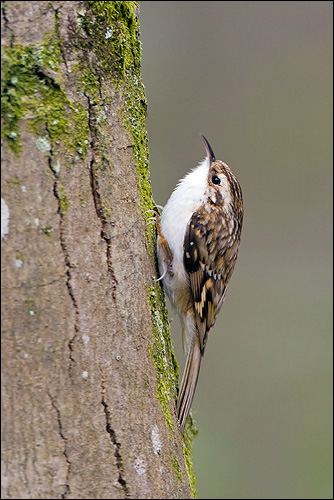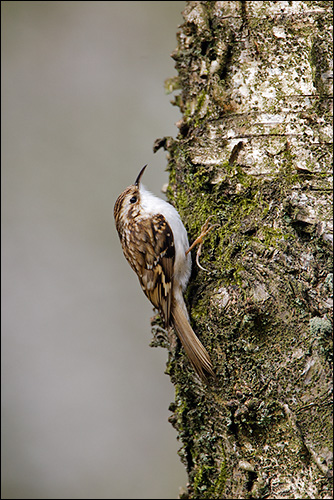Treecreeper (Certhia familiaris)
Id: Treecreepers unmistakable, small birds with long, decurved bills, mottled brown backs and clean white underparts. Hug closely to branches, upright.
Interesting Facts
- Famous for foraging method, climbing upright by clinging to tree trunks and branches.
- Long tail acts as brace and is stiffened.
- Studies show that they climb at 10cm per second when foraging.
- To climb they make hops upwards with both feet together, a bit like reverse abseiling. Each hop covers 6.6mm.
- In a day they may climb 2500m (higher than any British mountain).
- Unique nest site – often build boat-shaped nest behind flaking bark.
- Feed from any sort of tree. Spiralling upwards might help them forage over wider area.
- Avoid trees above large Wood Ant (Formica rufa) nests.
- Known to decimate population of surface-living invertebrates within 10m or so of nest – one of the few studies in which predators have been proven to affect populations of their prey.
General Information
The Treecreeper is a specialist, with just one main way of foraging, but a very successful one. Starting from the bottom of a tree trunk, the Treecreeper simply climbs up the bark, moving one foot up and then the other, often following a slight spiral trail as it ascends. As it goes it peers and probes into the many tiny holes, crevices and irregularities on the surface, picking insects off the bark and disturbing them from their hiding places. In this way it nourishes itself all day long, not departing from its upward progress except perhaps to work along the underside of a branch, or to flit down from high in each tree when its exploratory trail has been exhausted. It might be one-dimensional, but it is effective.
The Treecreeper’s simple method enables it to work the trunks and branches all year round, feeding on insects and spiders even in the midst of winter. Snow does not normally cover all its potential feeding sites, and because the Treecreeper
can reach hidden places unavailable to other birds, it has little competition.
It takes a very wide variety of insects, including beetles, earwings, moths and
lacewings. It does pick up a few seeds, mainly very small ones such as spruce
or pine, but it cannot survive for long without invertebrate food. Treecreepers
often join flocks of other small birds moving through the woods, taking
advantage of the collective vigilance against predators. At night they settle
into a small crevice, lying as flat as possible for shelter. In very
weak-barked trees a Treecreeper might excavate a hollow for itself, and on cold
nights several birds may congregate together, huddling to benefit from each
other’s body heat.
In the breeding season, Treecreepers build their nests in sites that they must come across frequently every day – small splits caused by bark flaking away from a tree trunk. In such fragile places they make a boat-shaped nest out of small fragments of twigs, roots, moss and grass. The nest may be so narrow that the
incubating bird cannot turn around. Sometimes the birds will use similar sites, for example in the small pits created by ivy and other creepers, or where similar small depressions are found on the bark itself.
Although most Treecreepers are monogamous, a few males are known to take more than one mate; there has even been one observation of two females sitting side by side
in the same nest, but on different clutches. Many Treecreepers have two broods and sometimes, in order to speed things up, the female will begin incubating a
second clutch before young from the first have left the nest.
| Habitat | Woodland of any type. |
|---|---|
| Food | Bark-living invertebrates, especially insects and spiders. |
| Movements | Sedentary. |
| Voice | Song high-pitched, whispering phrase that goes down scale then up at end. Call sibilant “shree” and variations. |
| Pairing style | Monogamous, but occasional bigamy by males. |
| Nesting | Solitary and territorial. |
| Nest | Boat-shaped structure behind bark flaking away from tree, or similar sites. |
| Productivity | 2 broods a year. |
| Eggs | Usually 6-7. |
| Incubation | 13-15 days, by female alone. |
| Parenting style | Young fed and tended by both parents. |
| Young | Nest-bound, altricial and downy. |
| Food to young | Insects. |
| Leaving nest | Fledge at 14-17 days. Young can often climb well as soon as they leave, and may be independent in a week. |


